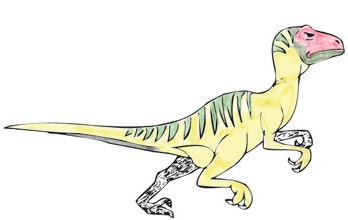Providing Information on Deinonychus
Yesterday we were emailed by one young dinosaur fan who asked when was the fearsome dinosaur called Deinonychus named? Our team members are always happy to help out and we emailed over the information, some Dromaeosauridae themed drawing materials and a fact sheet to assist this budding palaeontologist.
Deinonychus
Barnum Brown, the great American fossil hunter discovered the bones of a fast, agile predatory dinosaur in Wyoming back in 1931. He named this animal Daptosaurus (D. agilis), the name means “active lizard”. This was an informal name for the dinosaur, the fossilised bones were never officially described. It was not until the 1960s when another great American scientist and explorer, John Ostrom, found more bones of this lithe but powerful dinosaur that the story of Deinonychus really begins. Deinonychus (D. antirrhopus), the name means “terrible claw” due to that sharp, sickle-shaped second toe claw, was formally named in 1969.
An Image of Deinonychus
Picture credit: Everything Dinosaur
An Active Animal
Ostrom speculated that Deinonychus was a very active animal, capable of the sort of movements more akin to a mammal or a bird than to a reptile. He argued that dinosaurs such as Deinonychus were probably endothermic (warm-blooded). He depicted them as very active creatures, challenging the widely held view at the time of the Dinosauria being slow, cumbersome creatures. John Ostrom was ahead of his time in this respect.
It is John Ostrom and his assistant Bob Bakker who are widely credited with changing the academic world’s perception of the Dinosauria. Changing views about the dinosaurs in the 1960s and 1970s were known as the “Dinosaur Renaissance”.
To read a blog post about the “Dinosaur Renaissance”: The Dinosaur Renaissance.
Beasts of the Mesozoic “Raptors”
“Raptor” figures and models have proved to be extremely popular with dinosaur model collectors. Their popularity is epitomised by the Beasts of the Mesozoic articulated dinosaur model range: Beasts of the Mesozoic Models and Figures.







Leave A Comment